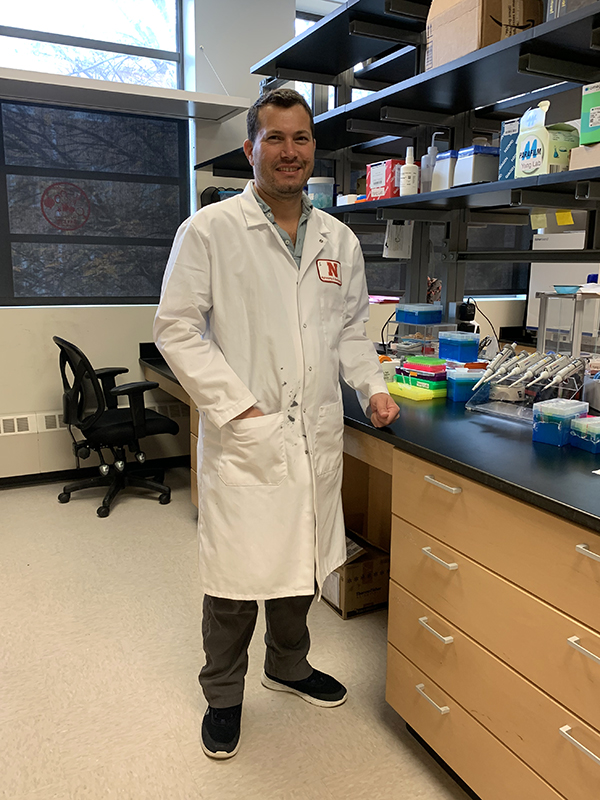Doctoral student studying history of Nebraska fires
Lincoln, Neb. —Jim Benes, a doctoral student in geography, studies fire history of the northern Great Plains, including multiple sites in the Nebraska Sand Hills.
Most afternoons, in a lab in Bessey Hall, Benes is busy processing charcoal samples. He analyzes fire history by taking cores from lakes or wetlands and then processing and sieving the charcoal particles within the core, centimeter by centimeter.
Study identifies connections among popcorn, microbiome, human health
Lincoln, Neb. —Plant breeders traditionally have focused on factors such as disease resistance, drought tolerance and ways to boost crop yields and the producer’s bottom line — all matters of practical importance. Recent research by Institute of Agriculture and Natural Resources scientists shows the value of considering an additional factor: strengthening a plant’s ability to promote human health.
Read Study identifies connections among popcorn, microbiome, human health
Niyorukundo extends grad students’ leadership in popcorn research
Lincoln, Neb. —Graduate students have played key roles in David Holding’s successful development of popcorn that offers increased nutritional benefits. Nebraska Today sat down with Jonathan Niyorukundo, the current grad student in Holding’s Beadle Center lab, to discuss the work and how it has shaped his academic path and career goals.
Read Niyorukundo extends grad students’ leadership in popcorn research
High Plains Ag Lab Presented Award for 150 Years of Observation
Lincoln, Neb. —During the Third Annual Cooperative Observer Program (COOP) Virtual Awards Ceremony on October 24, 2022, the High Plains Ag Lab (HPAL) in Sidney was recognized by the National Weather Service for its continuous service of observation for 150 years.
Read High Plains Ag Lab Presented Award for 150 Years of Observation
Project aims to boost ag tech through improved field connectivity
Lincoln, Neb. —Many farmers and agricultural experts see digital farming as the way of the future. Managing farms using sensors, drones and robots, artificial intelligence, advanced data analytics and more will be key to efficiently feeding the world’s increasing population, expected to reach 10 billion by 2050.
But maximizing agricultural technology’s potential hinges on a tool that most fields lack: high-speed internet connectivity.
Read Project aims to boost ag tech through improved field connectivity
Husker scientists add to university’s long history of bovine pinkeye study
Lincoln, Neb. —Research notes, reference materials, reports — such are the items to be found in the East Campus office of Dustin Loy, a professor in the University of Nebraska–Lincoln’s School of Veterinary Medicine and Biomedical Sciences. But Loy’s office also features an unusual drawing, a scientific one from deep in the university’s history.
Read Husker scientists add to university’s long history of bovine pinkeye study

Graduate student works on project to image maize roots
Most crop imaging studies focus on what grows above the ground, like leaf angle and plant height. Agronomy & Horticulture graduate student Musa Ulutas is doing a deep dive on corn characteristics by working on a project to image corn roots.
He decided to take this novel approach while working in a lab run by Jinliang Yang, Agronomy & Horticulture assistant professor. Musa is part of a research team working to analyze the corn microbiome to determine reaction to varying levels of nitrogen in the soil.
IANR celebrates third consecutive year of record-breaking research funding in 2022
Lincoln, Neb. —Researchers in UNL’s Institute of Agriculture and Natural Resources received nearly $71 million in externally sponsored research funding during the 2022 fiscal year – the highest annual total in the institute’s history.
Read IANR celebrates third consecutive year of record-breaking research funding in 2022
Feeling the heat? Wolf spider’s hunting rate may peak at 85 degrees
Lincoln, Neb. —Welcome to Pocket Science: a glimpse at recent research from Husker scientists and engineers. For those who want to quickly learn the “What,” “So what” and “Now what” of Husker research.
Read Feeling the heat? Wolf spider’s hunting rate may peak at 85 degrees
IANR tech boosts understanding of food crop traits, gut microbiome
Lincoln, Neb. —University of Nebraska–Lincoln researchers have identified specific sorghum genes and traits — including seed color — that contribute to a healthy gut microbiome, the ecosystem of microorganisms living in the GI tract.
Read IANR tech boosts understanding of food crop traits, gut microbiome








